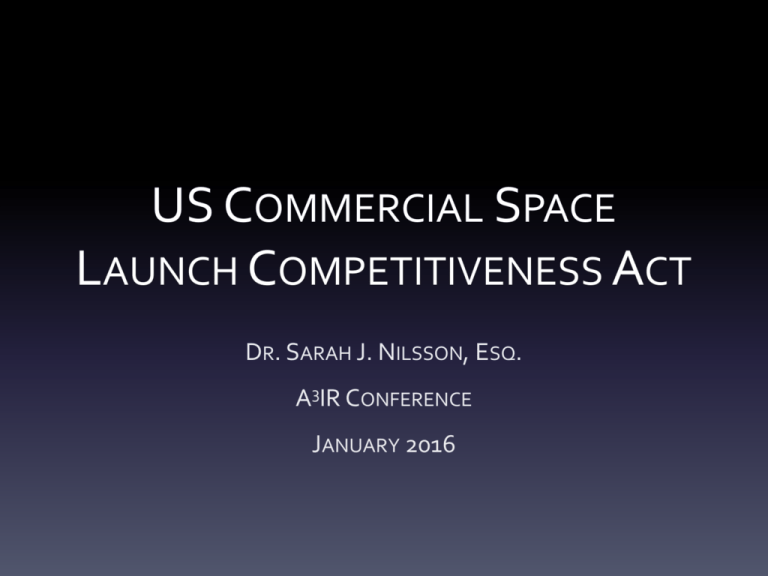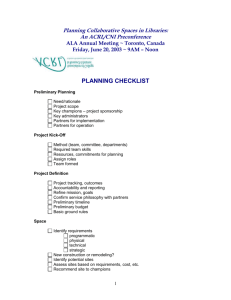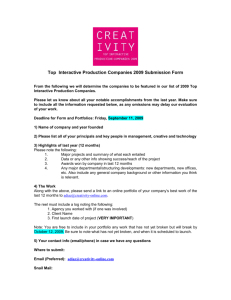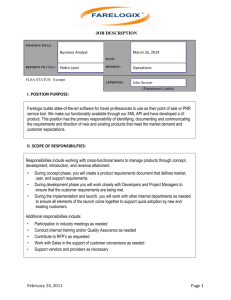SPACE Act of 2015 - SarahNilsson.org
advertisement

US COMMERCIAL SPACE LAUNCH COMPETITIVENESS ACT DR. SARAH J. NILSSON, ESQ. A3IR CONFERENCE JANUARY 2016 House Resolution (H.R.) 2262 • Passed the House of Representatives-May 21, 2015 • Passed Senate-November 11, 2015 • Finally it becomes law-November 25, 2015 • PL114-90 PL 114-90 An Act to facilitate a pro-growth environment for the developing commercial space industry by encouraging and creating , and for other purposes. Background 51 United States Code (U.S.C.) Subtitle V, Chapter 509 authorizes the Secretary of Transportation and, through delegations, the Federal Aviation Administration (FAA) Associate Administrator for Commercial Space Transportation, to both , and the operation of launch and reentry sites when carried out by U.S. citizens of within the U.S. Background 51 United States Code (U.S.C.) Subtitle V, Chapter 509 is formerly the Commercial Space Launch Act of 1984, as amended Background Chapter 509 directs the FAA to exercise this responsibility consistent with of the U.S., and to commercial space launch and reentry by the private sector. Background The Office of Commercial Space Transportation (AST) was established in 1984 as part of the Office of the Secretary of Transportation within the Department of Transportation (DOT). In November 1995, AST was transferred to the FAA as their only space-related line of business. Background On May 21, 1958, Senator A. S. "Mike" Monroney (D-OK) introduced a bill to create an independent Federal Aviation Agency to provide for the . Two months later, on August 23, 1958, the President signed the Federal Aviation Act, which transferred the Civil Aeronautics Authority's functions to a new independent Federal Aviation Agency responsible for civil aviation safety. Background “Our continuing mission is to provide the safest, most efficient aerospace system in the world.” Michael Huerta, Administrator Background The Commercial Space Launch Amendments Act (CSLAA) of 2004 assigned the FAA the responsibility for . In December 2006, the FAA issued human space flight regulations in accordance with its authority to . Background The CSLAA prohibits the FAA from proposing regulations governing the design or operation of a launch vehicle to protect the health and safety of crew and space flight participants until October 2015, or until a design feature or operating practice has resulted in a serious or fatal injury, or contributed to an event that posed a high risk of causing a death or serious injury, to crew or space flight participants during a licensed or permitted commercial human space flight. Background Until such time, the CSLAA only requires that a space flight participant be informed of the risks of taking a ride on a rocket. The FAA may also issue regulations setting reasonable requirements for space flight participants, including medical and training requirements. Background The CSLAA mandates that any regulations governing the design or operation of a launch vehicle to protect the health and safety of crew and space flight participants must take into consideration the evolving standards of safety in the commercial space flight industry. Background Limits in Regulatory Authority The U.S Congress has only incrementally expanded DOT/FAA authority over commercial space transportation 1984 – included launch authority 1998 – added reentry authority 2004 – added firm authority over commercial human space flight Background Limits in Regulatory Authority U.S. law contains limitations on FAA authority The FAA can only regulate The FAA does not certify space launch vehicles – it licenses the launch operation Mission success is the responsibility of the commercial launch operator Background is over Now for the US Commercial Space Launch Competitiveness Act US COMMERCIAL SPACE LAUNCH COMPETITIVENESS ACT TITLE I – SPURRING PRIVATE AEROSPACE COMPETITIVENESS AND ENTREPRENEURSHIP TITLE II – COMMERCIAL REMOTE SENSING TITLE III – OFFICE OF SPACE COMMERCE TITLE IV – SPACE RESOURCE EXPLORATION AND UTILIZATION TITLE I SPURRING PRIVATE AEROSPACE COMPETITIVENESS AND ENTREPRENEURSHIP - SPACE ACT OF 2015 United States Code Title 51 – National and Commercial Space Programs Chapter 509 – Commercial Space Launch Activities SECTION 102 – INTERNATIONAL LAUNCH COMPETITIVENESS It is the sense of Congress that it is in the public interest to update the methodology used to calculate the maximum probable loss from claims arising under 51 USC § 50913 SECTION 103 – INDEMNIFICATION FOR SPACE FLIGHT PARTICIPANTS Add: SECTION 104 – LAUNCH LICENSE FLEXIBILITY New language: and SECTION 106 – FEDERAL JURISDICTION - 50914 (Liability Insurance and Financial Responsibility Requirements) - Adding new language SECTION 107 – CROSS WAIVERS - Adding new language SECTION 108 – SPACE AUTHORITY - Not later than 120 days after enactment - Director of Office of Science and technology Policy + Secretary of State + Secretary of Transportation + Administrator of NASA etc. - Assess non-governmental activities in space - Identify appropriate authorization/supervision - Recommend safety approach to minimize burdens to industry - Exception: ISS activities per NASA Act of 2010 SECTION 109 – ORBITAL TRAFFIC MANAGEMENT It is the sense of Congress that an improved framework may be necessary for space traffic management of US government assets and US private sector assets in outer space and orbital debris mitigation SECTION 110 – SPACE SURVEILLANCE AND SITUATIONAL AWARENESS DATA - Not later than 120 days after enactment - Study of feasibility of processing and releasing safety-related space situational awareness data and information to any entity consistent with national security interests and public safety obligations of the US SECTION 111 – CONSENSUS STANDARDS AND EXTENSION OF CERTAIN SAFETY REGULATION REQUIREMENTS - Amends 50905 - Facilitation of Standards - Communication and Transparency - Interim Voluntary Industry Consensus Standards - Report not later than 270 days from enactment SECTION 112 – GOVERNMENT ASTRONAUTS - Amends 50901 - NASA needs to fly government astronauts within commercial launch vehicles and reentry vehicles – Commercial Crew Development Program SECTION 113 – STREAMLINE COMMERCIAL SPACE LAUNCH ACTIVITIES It is the sense of Congress that eliminating duplicative requirements and approvals for commercial launch and reentry operations will promote and encourage the development of the commercial space sector SECTION 114 – OPERATION AND UTILIZATION OF THE ISS - Maximum utilization of partnerships, scientific research, commercial applications, and exploration test bed capabilities of the ISS - Continuation through 2020 at least 2024 SECTION 115 – STATE COMMERCIAL LAUNCH FACILITIES It is the sense of Congress that state involvement, development, ownership, and operation of launch facilities can enable growth of Nation’s commercial suborbital and orbital space endeavors SECTION 116 – SPACE SUPPORT VEHICLES STUDY - Report not later than 1 year after enactment - Extent to which launch providers rely on services - Statutory, regulatory, and market barriers to use - Recommendations for legislative and regulatory action to ensure reduced barriers to use SECTION 117 – SPACE LAUNCH SYSTEM UPDATE - Space Shuttle now TITLE II COMMERCIAL REMOTE SENSING United States Code Title 51 – National and Commercial Space Programs Chapter 601 – Land Remote Sensing Policy Section 201 - Annual Reports Section 202 – Statutory Update Report TITLE III OFFICE OF SPACE COMMERCE United States Code Title 51 – National and Commercial Space Programs Chapter 507 – Office of Space Commercialization Section 301 – renaming Commercialization to Commerce Section 302 – Functions of Office of Space Commerce SECTION 302 – FUNCTIONS OF OFFICE OF SPACE COMMERCE - Foster conditions for economic growth and technological advancement of US space commerce industry - Coordinate space commerce policy issues and actions within Department of Commerce - Represent Department of Commerce in development of US policies and in negotiations with foreign countries - Promote advancement of US geospatial technologies - Provide support to US government organizations working on Space-based positioning navigation TITLE IV SPACE RESOURCE EXPLORATION AND UTILIZATION United States Code Title 51 – National and Commercial Space Programs Chapter 513 – Securities of the States and Private Entities NEW DEFINITIONS - space resource found on or within a single asteroid – an abiotic resource in situ (in its original place) in outer space – includes water and minerals NEW ADDITION A US citizen engaged in commercial recovery of an asteroid resource or a space resource under this chapter shall be entitled to any asteroid resource or space resource obtained, including to possess, own, transport, use, and sell the asteroid resource or space resource obtained in accordance with applicable law, including the international obligations of the US DISCLAIMER It is the sense of Congress that by enactment of this Act, the US does not thereby assert sovereignty or sovereign or exclusive rights or jurisdiction over, or the ownership of, any celestial body (referring to Outer Space Treaty of 1967)





